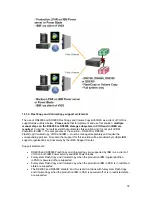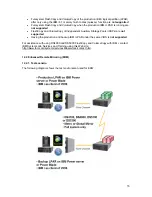
19
are not allowed to own any physical I/O adapters. Therefore, when managing Power servers, the
HMC is used most of the time, with IVM being used occasionally only on Power 520 and 550.
When managing Power blades, IVM must always be used.
8.1. Virtual SCSI and Ethernet adapters
VIOS providing storage to an IBM i client LPAR uses an existing function of the system firmware,
or Power Hypervisor: the capability to create virtual SCSI and Ethernet adapters in a partition.
Virtual adapters are created for each LPAR in the HMC. Virtual SCSI adapters are used for
storage and optical virtualization; virtual Ethernet adapters are used for network virtualization.
Note that using virtual I/O resources from VIOS does not preclude an IBM i client partition from
owning physical hardware when the server is HMC-managed. A mix of virtual and physical
hardware in the same partition is supported for IBM i in this environment, by assigning both types
of adapters to the partition in the HMC.
As mentioned above, using IVM for LPAR and virtualization management mandates using only
virtual resources for IBM i partitions. However, IVM provides the benefit of automatically creating
Virtual SCSI server (in VIOS) and client adapters (in IBM i) as virtual disk, optical and tape
resources are assigned to IBM i. For more information on LPAR management with IVM, consult
the IVM topic in the
PowerVM Editions Guide
, available at:
http://publib.boulder.ibm.com/infocenter/systems/scope/hw/index.jsp?topic=/arecu/arecukickoff.ht
m.
Note that IVM will automatically create only the first pair of Virtual SCSI server and client adapters
when disk and optical resources are virtualized to IBM i. Additional adapter pairs must be created
by using the IVM command line, available via a Telnet or SSH session to VIOS. Consult the
VIOS topic in the
PowerVM Editions Guide
for more information on using the IVM/VIOS
command line. IVM will automatically create a new Virtual SCSI adapter pair for each tape
resource assigned to IBM i.
8.2. Storage virtualization
8.2.1. HMC and IVM configuration
For VIOS to virtualize LUNs created on open storage to an IBM i client partition, configuration
takes place both in the HMC (or IVM) and in VIOS. As mentioned in the previous section, no
explicit Virtual SCSI configuration is necessary in IVM the majority of the time.
In the HMC, the minimum required configuration is:
•
One virtual SCSI server adapter in the host partition
•
One virtual SCSI client adapter in the client partition
This virtual SCSI adapter pair allows the client partition to send read and write I/O operations to
the host partition. More than one virtual SCSI pair can exist for the same client partition in this
environment. To minimize performance overhead in VIOS, the virtual SCSI connection is used to
send I/O requests, but not for the actual transfer of data. Using the capability of the Power
Hypervisor for Logical Remote Direct Memory Access (LRDMA), data are transferred directly
from the Fibre Channel adapter in VIOS to a buffer in memory of the IBM i client partition.
In an IBM i client partition, a virtual SCSI client adapter is recognized as a type
290A DCxx
storage controller device. The screenshot below depicts the virtual SCSI client adapter, as well
as several open storage LUNs and an optical drive virtualized by VIOS:
Содержание I VIRTUALIZATION - READ ME FIRST 7-9-2010
Страница 13: ...13...






























